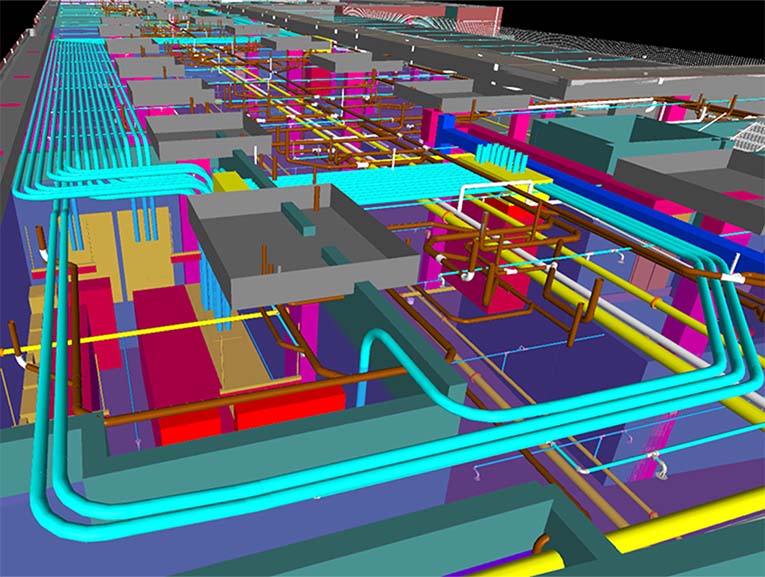
AEC Industry has changed dramatically due to the digital revolution in architecture, engineering, and construction sectors for the past ten years. One of the major transformations involves the use of Building Information Modeling (BIM), which has completely altered the way the electrical systems are designed and integrated within projects. Old electrical designer jobs used to be very basic, and they mainly used 2D drafting tools like AutoCAD.
The primary requirement for BIM Electrical Designer roles was the increasing complexity of construction projects and the need for higher precision. Instead of relying on old-fashioned drafting methods, BIM combines 3D modeling with intelligent data and enables electrical designers to collaborate with other disciplines, such as mechanical, plumbing, and structural teams. This strategy facilitates proper coordination and aid in the identification of clashes even before the construction starts, hence, the saving of time and the reduction of costs.
Why do Electrical Designers need to Embrace BIM?
The demand for Electrical BIM Designers has escalated with more and more companies converting to digital workflows. Authorities are now demanding BIM MEP services for the purpose of improving efficiency and sustainability in infrastructures globally. Moreover, electric designers who don't embrace the technology or don't upgrade their technical skills may have a hard time in the market.
Challenges Faced by Electrical Designers
The problem facing electrical designers using traditional electronics is that of the absence of the growth of their careers and the potential for the increase of their income. A person that depends only on traditional ways of doing things is more likely to face problems associated with his career such as slow progress, low salaries and limited opportunities.
1. Low Salary and Stagnant Growth
One of the main challenges facing traditional 2D electrical designers is the lack of wage increases. In India, a beginner's salary is about ₹25,000-₹35,000 p.m., the pay scale for the 5-7 years experienced person is ₹40,000-₹50,000 p.m., and senior roles are rewarded with salaries ranging between ₹50,000-₹70,000 per month. Electrical BIM designers, on the other hand, get significantly higher paychecks due to the high demand for their craftsmanship.
2. Slow Career Growth & Limited Promotions
Common electrical design practices the experts used to follow restrict the opportunities for career development according to the obsolete AutoCAD, exposure to global projects, and manual labor. The BIM MEP adoption process entails the possession of advanced computer skills, which results in the skills gap and thus, slower development for the traditional designers.
3. Limited Job Opportunities
The adoption of BIM often makes the work of electrical drafters who are not competent in Revit MEP less attractive, thus resulting in the fact that there is a bigger demand for IT-savvy BIM engineers who are able to use Revit MEP, Navisworks, and Dynamo. The main points include obligatory BIM government use (EU/US), smart city MEP demand, and communication of remote work at the global level. The failure to do so may lead to unemployment.
Also Read: How to transition from Electrical Designer to BIM Electrical Designer
How BIM Designer Roles Offer Higher Salaries and Faster Career Growth?
BIM is a promising career path for an electrical designer it offers higher salaries, faster career growth, and improved working conditions. This is because BIM Electrical Designers are in the first place. Among the reasons why there is a chance for getting more salary are Entry-level employees (₹31,000-₹45,000), mid-level employees (₹50,000-₹75,000), and senior employees (₹80,000-₹1,20,000).
1. Faster Career Progression with BIM
One of the many advantages that BIM experts have over their peers in the traditional electrical design field is the time it takes to step up the career ladder. BIM qualification provides the basis for moving professionals to higher income senior levels such as: BIM Modeler (Electrical) BIM Coordinator BIM Manager MEP BIM Lead Each of these occupational roles will prove beneficial not in salary prospects as well as leadership chances, but also a possibility of a diverse horizon globally.
2. Global Demand and Expanded Job Opportunities
Job-seekers in the electrical design niche who are newly employed in the BIM field can enjoy different career paths worldwide, ranging from digital nomadship to the professional industry driven by remote infrastructure systems, remote collaboration, and global applications. Nonetheless, taking up BIM is the safest way to get a job and become an international professional.
3. Job Stability and Work-Life Balance
BIM professionals are typically working in an office-based job, where they are enjoying A stabilized work environment linked to fixed career opportunities. Less frequent visits to work sites, allowing them to have a healthier work-life balance. The flexibility to work from a remote place is why it remains a great career, even in today's changing environments.
BIM Electrical Designer Job Advantages
Working as a BIM Electrical Designers presents several amazing features that make it a favorable occupation for electrical design professionals. In contrast to the common practices of electrician jobs; fieldwork such as inspecting and maintaining equipment and unpredictable schedules, BIM Electrical Designers experience more stable and scheduled working conditions.

1. Desk Job with Cutting-Edge Technology
A BIM Electrical Designer has the possibility of changing his position from the field to the design desk, which involves getting rid of the site visits and the manual drafting. The services of designing, analyzing, and optimizing of electrical systems are now done through the use of Revit MEP and BIM MEP services that are digitally prepared. This allows for layouts to be highly detailed and error-free, therefore provide an increase in project efficiency and accuracy and reducing rework.
2. Job Stability in a Growing Industry
BIM Electrical Designers are in high demand as the BIM MEP is more widely adopted. BIM roles offer more stable employment compared to traditional positions. Electrician salaries are high significantly at this time. A BIM project that is global and Revit MEP/MEP training that is available on the job guarantee the security of the job and provide a high paying package to the worker.
3. Better Work-Life Balance
BIM Electric Designers benefit from the use of a digital platform (Revit MEP), and that's why they have better work-life balance than traditional designers. It is it helps to work from fixed schedule, from anywhere you are through cloud-based BIM collaboration, with reduced physical exertion, and with an opportunity to choose freelancing or get a job in a multinational corporation.
4. Long-Term Career Growth in BIM
The future of electrical design is BIM-driven, as a result of which continuous skill upgrades are a must. BIM Electric Designers can fit into such positions as Senior Designer, Coordinator, Lead, Manager, and Consultant. BIM MEP makes it possible for the use of advanced technology throughout the projects, thus, improvements, higher salaries, promotions, the possibility of international careers, talk about the pros.
Also Read: Top 50 MEP Interview Questions & Answers 2025
Important BIM Skills and Training
Entering the BIM Electrical Design when you are not just learning the basics will definitely need more than just comprehension. You need to have hands-on experience with the most used software in the industry and a perfect comprehension of how electrical systems can be merged within the MEP (Mechanical, Electrical, and Plumbing) framework.

Important Skills That a BIM Electrical Designer Should Have For one, a good electrical designer should master several essential skills such as:
- Revit MEP Expertise: Efficiency in designing, modeling, and analyzing the MEP systems learned basically.
- MEP Design Fundamentals: Understanding the interaction of HVAC, plumbing, and electrical systems.
- BIM Coordination & Clash Detection: The capability of identifying and resolving conflicts between various building systems.
- BIM Execution Plans (BEPs): Establishing BIM strategies to speed up project workflows.
- Electrical Load Calculations: The ability to accurately relate power inputs to efficient electrical systems.
- MEP BIM Workflow: The understanding of not only the electrical BIM services but also the construction process as a whole matters.
Novatr Course for Electrical Designers
If you want to make yourself a high-profile professional and get a promotion fast, Novatr’s BIM Professional Program for MEP Engineers is built to offer practical skills in the following areas:
- Industry-Standard Software: Later on, you will be able to work in a joined team and use your expertise with tools such as Autodesk Revit MEP, Navisworks, and BIM 360.
- Practical Learning: Being part of practical work and case studies which are written in a way to stimulate the experiences in a real workplace.
- Expert Mentorship: The experts in the field are the ones that teach you in real time.
- Job Assistance: Take advantage of career counseling and the possibility to be placed in the top AEC (Architecture, Engineering, and Construction) firms.
- Flexible Learning Schedule: This is a project that fits into your other work arrangements so you can pick your learning pace.
Also Read: BIM for MEP: A Complete Guide 2025
Conclusion
Changing from traditional electrical designs to a BIM Electrical Designer is a well-thought-out career move that offers higher pay, job security, and long-term growth. Due to the very fact that there is an increasing need for BIM MEP services, the people who are trained in Revit MEP, MEP design, and BIM coordination are quickly becoming what others call indispensable. Novatr's BIM Professional Program for MEP Engineers provides the necessary skills for electrical designers and makes them stand out in the field. The professionals who go through Novatr's training can not only get industry-relevant proficiency but also open the doors to high-paying jobs that will later on influence the AEC industry. Visit Novatr’s resource page for more. The moment is just perfect for you to invest in learning new skills and thus become a BIM Electrical Designer who is highly sought after!
FAQs
1. What is a BIM Electrical Designer?
A BIM Electrical Designer is an expert who employs Building Information Modeling (BIM) technology in order to project, analyze, and coordinate electrical systems in various construction projects. They are not similar to the normal electric designers; they are the ones who use highly advanced software such as Revit MEP and Navisworks to make the most detailed 3D models for a very effective management of the project.
2. How is a BIM Electrical Designer different from a traditional Electrical Designer?
A classic electrical designer mainly operates with 2D drawing tools such as AutoCAD and deals with the on-site technology for hands-on checks and installations. Unlike the traditional designer, the BIM Electrical Designer is the one who uses Revit MEP and the services that can be provided with BIM MEP to digitally fashion and optimize electrical layouts thus making the system more efficient and less time-consuming.
3. What is the salary difference between an Electrical Designer and a BIM Electrical Designer?
Electric designer earns are on average lower due to the manual labor and the low demand. In contrast, electrical BIM design is in higher demand which leads to the higher compensation for this position with the increasing implementation of BIM technology in the AEC industry. Professionals who have superb skills in Revit MEP and BIM coordination can make 30-50% more than the standard electrical designer workers.
4. What are the job responsibilities of a BIM Electrical Designer?
The BIM Electrical Designer job description is made up of the following: Drawing electric systems by using the Revit MEP Having a dialogue with HVAC and piping systems team for better systems integration Checking the possibility of occurrence of the various conditions and coordinating these with Navisworks Make the MEP design more sustainable by optimizing energy with the use of the latest AutoCAD technology Creating BIM models for construction and facilities management for clients or managing facilities
Was this content helpful to you







